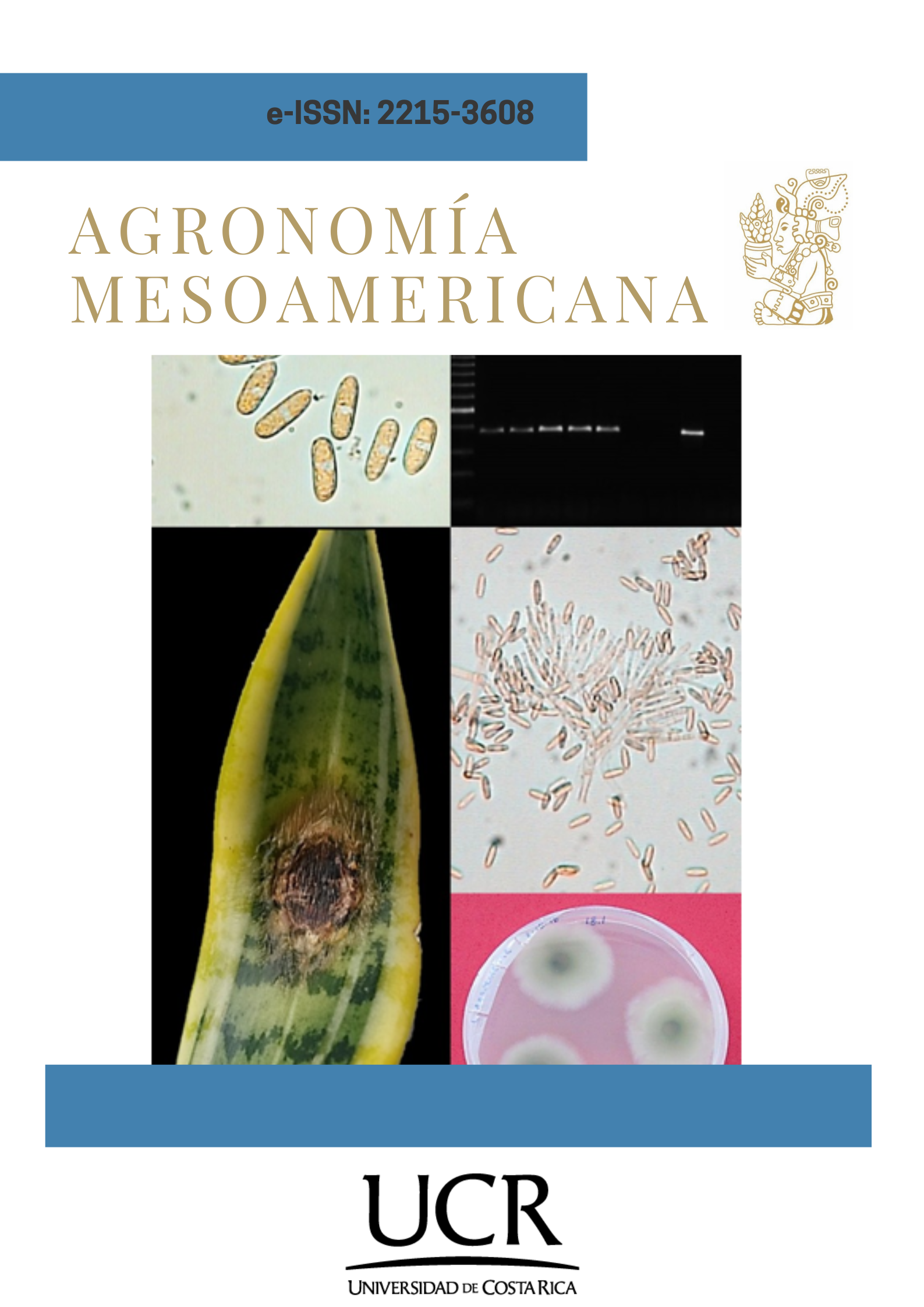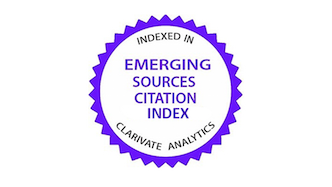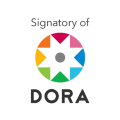Métodos moleculares para la detección específica de Colletotrichum sansevieriae
DOI:
https://doi.org/10.15517/am.2025.62815Palabras clave:
RFLP, antracnosis, enfermedad vegetal, gen β-tubulina, patógeno vegetal, diagnóstico fúngicoResumen
Introducción. La antracnosis de Sansevieria, causada por Colletotrichum sansevieriae, representa un riesgo significativo para el cultivo y la exportación de esta planta ornamental. Los métodos efectivos y rápidos de identificación de este patógeno son cruciales para implementar medidas de control que prevengan su propagación a áreas no infestadas. Objetivo. Implementar y optimizar métodos moleculares para la identificación rápida y confiable de C. sansevieriae. Materiales y métodos. Durante 2016, se analizó un fragmento del gen β-tubulina-2 (β-tub2) de C. sansevieriae aislado de una finca local en Alajuela, Costa Rica. Se implementó PCR-RFLP del fragmento parcial del gen β-tubulina-2 (β-tub2) con la enzima MseI (Tru1I). Además, se aplicaron cebadores específicos para la detección de C. sansevieriae y análisis PCR-RFLP del fragmento amplificado. Resultados. La digestión produjo de manera consistente un patrón de restricción de dos bandas específico para C. sansevieriae. Los cebadores diseñados amplificaron con éxito un fragmento de 383 pb del β-tub2 de todas las cepas de C. sansevieriae probadas. No se observó amplificación de otras especies de Colletotrichum dentro de los complejos C. gloeosporioides y C. acutatum, ni de aislamientos de C. truncatum y Fusarium oxysporum. Además, este sitio de restricción, ubicado dentro del amplicón generado por los cebadores específicos para C. sansevieriae, permitió la validación exitosa de la especie mediante digestión. Conclusiones. Ambos métodos basados en PCR demostraron ser lo suficientemente sensibles como para detectar C. sansevieriae en hojas de Sansevieria infectadas de manera natural y artificial sin necesidad de aislar el patógeno en cultivos puros, lo que hace que el proceso diagnóstico sea más eficiente y accesible.
Referencias
Afanador-Kafuri, L., González, A., Gañán, L., Mejía, J. F., Cardona, N., & Álvarez, E. (2014). Characterization of the Colletotrichum species causing anthracnose in Andean blackberry in Colombia. Plant Disease, 98(11), 1503–1513. https://doi.org/10.1094/PDIS-07-13-0752-RE DOI: https://doi.org/10.1094/PDIS-07-13-0752-RE
Aldaoud, R., DeAlwis, S., Salib, S., Cunnington, J. H., & Doughty, S. (2011). First record of Colletotrichum sansevieriae on Sansevieria sp. (mother-in-law’s tongue) in Australia. Australasian Plant Disease Notes, 6(1), 60–61. https://doi.org/10.1007/s13314-011-0020-z DOI: https://doi.org/10.1007/s13314-011-0020-z
Álvarez, E., Gañán, L., Rojas-Triviño, A., Mejía, J. F., Llano, G. A., & González, A. (2014). Diversity and pathogenicity of Colletotrichum species isolated from soursop in Colombia. European Journal of Plant Pathology, 139, 325–338. https://doi.org/10.1007/s10658-014-0388-7 DOI: https://doi.org/10.1007/s10658-014-0388-7
Bhunjun, C. S., Phukhamsakda, C., Jayawardena, R. S., Jeewon, R., Promputtha, I., & Hyde, K. D. (2021). Investigating species boundaries in Colletotrichum. Fungal Diversity, 107(1), 107–127. https://doi.org/10.1007/s13225-021-00471-z DOI: https://doi.org/10.1007/s13225-021-00471-z
Brand, T., & Wichura, A. (2023). First report on Colletotrichum sansevieriae causing anthracnose of Sansevieria trifasciata in Germany. Gesunde Pflanzen, 75(1), 61–66. https://doi.org/10.1007/s10343-022-00777-1 DOI: https://doi.org/10.1007/s10343-022-00777-1
Campoverde, E. V., & Palmateer, A. J. (2012). Colletotrichum sansevieriae causing anthracnose of Sansevieria trifasciata ‘Laurentii’ and ‘Moonshine’ in South Florida. Proceedings of the Florida State Horticultural Society, 125, 359–360. https://journals.flvc.org/fshs/issue/view/4046
Cao, L., Shi, K., Liu, Y., Xie, X., Sun, X., Dong, W., Wang, C., & Ma, L. (2024). Identification of specific genes as molecular markers for rapid and accurate detection of oil-tea Camellia anthracnose pathogen Colletotrichum fructicola in China. Frontiers in Microbiology, 15, Article 1442922. https://doi.org/10.3389/fmicb.2024.1442922 DOI: https://doi.org/10.3389/fmicb.2024.1442922
Chung, W.-H., Chung, W.-C., Peng, M.-T., Yang, H.-R., & Huang, J.-W. (2010). Specific detection of benzimidazole resistance in Colletotrichum gloeosporioides from fruit crops by PCR-RFLP. New Biotechnology, 27(1), 17–24. https://doi.org/10.1016/j.nbt.2009.10.004 DOI: https://doi.org/10.1016/j.nbt.2009.10.004
Damm, U., Cannon, P. F., Woudenberg, J. H. C., & Crous, P. W. (2012). The Colletotrichum acutatum species complex. Studies in Mycology, 73(1), 37–113. https://doi.org/10.3114/sim0010 DOI: https://doi.org/10.3114/sim0010
Dela Cruz, M., Christensen, J. H., Thomsen, J. D., & Müller, R. (2014). Can ornamental potted plants remove volatile organic compounds from indoor air? — A review. Environmental Science and Pollution Research, 21(24), 13909–13928. https://doi.org/10.1007/s11356-014-3240-x DOI: https://doi.org/10.1007/s11356-014-3240-x
Doyle, J. J., & Doyle, J. L. (1987). A rapid DNA isolation procedure for small quantities of fresh leaf tissue. Phytochemical Bulletin, 19, 11–15.
Eaton, M. J., Edwards, S., Inocencio, H. A., Machado, F. J., Nuckles, E. M., Farman, M., Gauthier, N. A., & Vaillancourt, L. J. (2021). Diversity and cross-infection potential of Colletotrichum causing fruit rots in mixed-fruit orchards in Kentucky. Plant Disease, 105(4), 1115–1128. https://doi.org/10.1094/PDIS-06-20-1273-RE DOI: https://doi.org/10.1094/PDIS-06-20-1273-RE
Ferrucho, R. L., Marín-Ramírez, G. A., Ochoa-Corona, F., & Ángel C., C. A. (2024). PCR-based detection for the quarantine fungus Colletotrichum kahawae, a biosecurity threat to the coffee (Coffea arabica) industry worldwide. Plant Disease, 108(9), 2615–2624. https://doi.org/10.1094/PDIS-09-23-1788-SR DOI: https://doi.org/10.1094/PDIS-09-23-1788-SR
Gang, G.-H., Cho, H. J., Kim, H. S., Kwack, Y.-B., & Kwak, Y.-S. (2015). Analysis of fungicide sensitivity and genetic diversity among Colletotrichum species in sweet persimmon. Plant Pathology Journal, 31(2), 115–122. https://doi.org/10.5423/PPJ.OA.03.2015.0033 DOI: https://doi.org/10.5423/PPJ.OA.03.2015.0033
Gautam, A. K., Avasthi, S., & Bhadauria, R. (2012). Colletotrichum sansevieriae on Sansevieria trifasciata — A report from Madhya Pradesh, India. Plant Pathology & Quarantine, 2(2), 190–192. https://plantpathologyquarantine.org/volume-2/issue-2.html DOI: https://doi.org/10.5943/ppq/2/2/12
Glass, N. L., & Donaldson, G. C. (1995). Development of primer sets designed for use with the PCR to amplify conserved genes from filamentous ascomycetes. Applied and Environmental Microbiology, 61, 1323–1330. https://doi.org/10.1128/aem.61.4.1323-1330.1995 DOI: https://doi.org/10.1128/aem.61.4.1323-1330.1995
Grskovich, M., Creswell, T., & Bonkowski, J. (2024). First Report of Anthracnose Caused by Colletotrichum sansevieriae on Dracaena trifasciata (Snake Plant) in Tennessee. Plant Disease, 108(12), 3650. https://doi.org/10.1094/PDIS-05-24-1049-PDN DOI: https://doi.org/10.1094/PDIS-05-24-1049-PDN
Hall, T. A. (1999). BioEdit: A user-friendly biological sequence alignment editor and analysis program for Windows 95/98/NT. Nucleic Acids Symposium Series, 41, 95–98.
Huang, R., Sun, W., Wang, L., Li, Q., Huang, S., Tang, L., Guo, T., Mo, J., & Hsiang, T. (2021). Identification and characterization of Colletotrichum species associated with anthracnose disease of banana. Plant Pathology, 70(8), 1827–1837. https://doi.org/10.1111/ppa.13426 DOI: https://doi.org/10.1111/ppa.13426
Kee, Y. J., Zakaria, L., & Mohd, M. H. (2020a). Identification, pathogenicity, and histopathology of Colletotrichum sansevieriae causing anthracnose of Sansevieria trifasciata in Malaysia. Journal of Applied Microbiology, 129(3), 626–636. https://doi.org/10.1111/jam.14640 DOI: https://doi.org/10.1111/jam.14640
Kee, Y. J., Zakaria, L., & Mohd, M. H. (2020b). Morphology, phylogeny and pathogenicity of Fusarium species from Sansevieria trifasciata in Malaysia. Plant Pathology, 69(3), 442–454. https://doi.org/10.1111/ppa.13138 DOI: https://doi.org/10.1111/ppa.13138
Khalumba, M. L., Mbugua, P. K., & Kung’u, J. B. (2005). Uses and conservation of some highland species of the genus Sansevieria Thunb in Kenya. African Crop Science Conference Proceedings, 7, 527–532.
Kumar, S., Stecher, G., Li, M., Knyaz, C., & Tamura, K. (2018). MEGA X: Molecular evolutionary genetics analysis across computing platforms. Molecular Biology and Evolution, 35(6), 1547–1549. https://doi.org/10.1093/molbev/msy096 DOI: https://doi.org/10.1093/molbev/msy096
Lee, D.-H., Kim, D.-H., Jeon, Y.-A., Uhm, J.-Y., & Hong, S.-B. (2007). Molecular and cultural characterization of Colletotrichum spp. causing bitter rot of apples in Korea. Plant Pathology Journal, 23(2), 37–44. https://doi.org/10.5423/PPJ.2007.23.2.037 DOI: https://doi.org/10.5423/PPJ.2007.23.2.037
Li, J., Deng, H., Diao, L.-G., Zhang, R.-Q., Li, J.-Y., Liu, H.-X., & Jin, J. (2023). First report of anthracnose caused by Colletotrichum sansevieriae on Sansevieria trifasciata var. laurentii in China. Plant Disease, 107(2), 583. https://doi.org/10.1094/PDIS-03-22-0673-PDN DOI: https://doi.org/10.1094/PDIS-03-22-0673-PDN
Li, Y. L., Zhou, Z., Lu, W., & Ye, J. R. (2013). First report of a Chaetomella sp. causing a leaf spot on Sansevieria trifasciata in China. Plant Disease, 97(7), 992. https://doi.org/10.1094/PDIS-10-12-0993-PDN DOI: https://doi.org/10.1094/PDIS-10-12-0993-PDN
Ma, Z., & Michailides, T. J. (2007). Approaches for eliminating PCR inhibitors and designing PCR primers for the detection of phytopathogenic fungi. Crop Protection, 26(2), 145–161. https://doi.org/10.1016/j.cropro.2006.04.014 DOI: https://doi.org/10.1016/j.cropro.2006.04.014
Maharaj, A., & Rampersad, S. N. (2012). Genetic differentiation of Colletotrichum gloeosporioides and C. truncatum associated with anthracnose disease of papaya (Carica papaya L.) and bell pepper (Capsicum annuum L.) based on ITS PCR-RFLP fingerprinting. Molecular Biotechnology, 50, 237–249. https://doi.org/10.1007/s12033-011-9434-2 DOI: https://doi.org/10.1007/s12033-011-9434-2
Martinez-Culebras, P. V., Barrio, E., Garcia, M. D., & Querol, A. (2000). Identification of Colletotrichum species responsible for anthracnose of strawberry based on the internal transcribed spacers of the ribosomal region. FEMS Microbiology Letters, 189(1), 97–101. https://doi.org/10.1111/j.1574-6968.2000.tb09213.x DOI: https://doi.org/10.1016/S0378-1097(00)00260-3
Martinez-Culebras, P. V., Querol, A., Suarez-Fernandez, M. B., Garcia-Lopez, M. D., & Barrio, E. (2003). Phylogenetic relationships among Colletotrichum pathogens of strawberry and design of PCR primers for their identification. Journal of Phytopathology, 151(3), 135–143. https://doi.org/10.1046/j.1439-0434.2003.00694.x DOI: https://doi.org/10.1046/j.1439-0434.2003.00694.x
McHenry, D. J., & Aćimović, S. G. (2024). New species-specific real-time PCR assays for colletotrichum species causing bitter rot of apple. Microorganisms, 12(5), Article 878. https://doi.org/10.3390/microorganisms12050878 DOI: https://doi.org/10.3390/microorganisms12050878
Nakamura, M., Ohzono, M., Iwai, H., & Arai, K. (2006). Anthracnose of Sansevieria trifasciata caused by Colletotrichum sansevieriae sp. nov. Journal of General Plant Pathology, 72(4), 253–256. https://doi.org/10.1007/s10327-006-0280-1 DOI: https://doi.org/10.1007/s10327-006-0280-1
O’Donnell, K., & Cigelnik, E. (1997). Two divergent intragenomic rDNA ITS2 types within a monophyletic lineage of the fungus Fusarium are nonorthologous. Molecular Phylogenetics and Evolution, 7(1), 103–116. https://doi.org/10.1006/mpev.1996.0376 DOI: https://doi.org/10.1006/mpev.1996.0376
O’Donnell, K., Kistler, H. C., Cigelnik, E., & Ploetz, R. C. (1998). Multiple evolutionary origins of the fungus causing Panama disease of banana: Concordant evidence from nuclear and mitochondrial gene genealogies. Proceedings of the National Academy of Sciences of the United States of America, 95(5), 2044–2049. https://doi.org/10.1073/pnas.95.5.2044 DOI: https://doi.org/10.1073/pnas.95.5.2044
Palmateer, A. J., Tarnowski, T. L. B., & Lopez, P. (2012). First report of Colletotrichum sansevieriae causing anthracnose of Sansevieria trifasciata in Florida. Plant Disease, 96(2), 293. https://doi.org/10.1094/PDIS-06-11-0539 DOI: https://doi.org/10.1094/PDIS-06-11-0539
Park, J. H., Han, K. S., Kim, J. Y., & Shin, H. D. (2013). First report of anthracnose caused by Colletotrichum sansevieriae on Sansevieria in Korea. Plant Disease, 97(11), 1510. https://doi.org/10.1094/PDIS-04-13-0402-PDN DOI: https://doi.org/10.1094/PDIS-04-13-0402-PDN
Pérez-León, G., Castillo-Matamoros, R., Chavarría-Pérez, L., Brenes-Angulo, A., & Gómez-Alpízar, L. (2015). Combate químico de la antracnosis de Sansevieria Trifasciata Var. Hahnii en un sistema de hojas separadas. Agronomía Mesoamericana, 26(2), 305–313. http://dx.doi.org/10.15517/am.v26i2.19323 DOI: https://doi.org/10.15517/am.v26i2.19323
Pérez-León, G., Chavarría-Pérez, L., Araya-Quesada, J., & Gómez-Alpízar, L. (2013). Identificación del agente causal de la antracnosis de Sansevieria spp. en Costa Rica. Agronomía Costarricense, 37(1), 39–50. https://doi.org/10.15517/rac.v37i1.10711 DOI: https://doi.org/10.15517/rac.v37i1.10711
Pinzón Gutiérrez, Y. A., Bustamante, S. L., & Buitrago Hurtado, G. (2013). Diagnóstico molecular diferencial Colletotrichum gloeosporioides y Fusarium oxysporum en ñame (Dioscorea sp.). Revista Colombiana de Biotecnología, 15(1), 52–60.
Prakoso, A. B., Suryanti, S., & Widiastuti, A. (2019). Molecular detection of Colletotrichum spp. on postharvest commodities of horticulture in Central Java and Yogyakarta, Indonesia. AIP Conference Proceedings, 2099(1), 1–6. https://doi.org/10.1063/1.5098422 DOI: https://doi.org/10.1063/1.5098422
Ramdeen, S., & Rampersad, S. N. (2013). Intraspecific differentiation of Colletotrichum gloeosporioides sensu lato based on in silico multilocus PCR-RFLP fingerprinting. Molecular Biotechnology, 53(2), 170–181. https://doi.org/10.1007/s12033-012-9509-8 DOI: https://doi.org/10.1007/s12033-012-9509-8
Ramdial, H., & Rampersad, S. N. (2015). Characterization of Colletotrichum spp. causing anthracnose of bell pepper (Capsicum annuum L.) in Trinidad. Phytoparasitica, 43, 37–49. https://doi.org/10.1007/s12600-014-0428-z DOI: https://doi.org/10.1007/s12600-014-0428-z
Rampersad, S. N. (2011). Molecular and phenotypic characterization of Colletotrichum species associated with anthracnose disease of papaya in Trinidad. Plant Disease, 95(10), 1244–1254. https://doi.org/10.1094/PDIS-02-11-0080 DOI: https://doi.org/10.1094/PDIS-02-11-0080
Rampersad, K., Ramdial, H., & Rampersad, S. N. (2016). Utility of internally transcribed spacer region of rDNA (ITS) and β-tubulin gene sequences to infer genetic diversity and migration patterns of Colletotrichum truncatum infecting Capsicum spp. Ecology and Evolution, 6(2), 593–606. https://doi.org/10.1002/ece3.1918 DOI: https://doi.org/10.1002/ece3.1918
Rêgo, M., Lopes, A., Barros, R., Lamas, A. M., Costa, M. F., & Ferreira-Gomes, R. L. (2020). Morphological characterization and genetic diversity in ornamental specimens of the genus Sansevieria. Revista Caatinga, 33(4), 985–992. https://doi.org/10.1590/1983-21252020v33n413rc DOI: https://doi.org/10.1590/1983-21252020v33n413rc
Ruiz-Campos, C., Umaña-Rojas, G., & Gómez-Alpízar, L. (2017). Molecular and morphological identification of Colletotrichum species in papaya fruits (Carica papaya) ‘Pococí’ hybrid. Phytopathology, 107(7), S.4.16. https://apsjournals.apsnet.org/doi/epdf/10.1094/PHYTO-107-7-S4.7
Ruiz-Campos, C., Umaña-Rojas, G., & Gómez-Alpízar, L. (2022). Identificación multilocus de especies de Colletotrichum asociadas a la antracnosis de papaya. Agronomía Mesoamericana, 33(1), Artículo 45495. http://dx.doi.org/10.15517/am.v33i1.45495 DOI: https://doi.org/10.15517/am.v33i1.45495
Saghai-Maroof, M. A., Soliman, K. M., Jorgensen, R. A., & Allard, R. W. (1984). Ribosomal DNA spacer-length polymorphism in barley: Mendelian inheritance, chromosomal location and population dynamics. Proceedings of the National Academy of Sciences of the United States of America, 81(24), 8014–8018. https://doi.org/10.1073/pnas.81.24.8014 DOI: https://doi.org/10.1073/pnas.81.24.8014
Schena, L., Mosca, S., Cacciola, S. O., Faedda, R., Sanzani, S. M., Agosteo, G. E., Sergeeva, V., & Magnano di San Lio, G. (2014). Species of the Colletotrichum gloeosporioides and C. boninense complexes associated with olive anthracnose. Plant Pathology, 63(2), 437–446. https://doi.org/10.1111/ppa.12110 DOI: https://doi.org/10.1111/ppa.12110
Silva, A. O., Savi, D. C., Gomes, F. B., Gos, F. M. W. R., Silva, G. J., & Glienke, C. (2017). Identification of Colletotrichum species associated with postbloom fruit drop in Brazil through GAPDH sequencing analysis and multiplex PCR. European Journal of Plant Pathology, 147, 731–748. https://doi.org/10.1007/s10658-016-1038-z DOI: https://doi.org/10.1007/s10658-016-1038-z
Silva, D. N., Talhinhas, P., Várzea, V., Cai, L., Paulo, O. S., & Batista, D. (2012). Application of the Apn2/MAT locus to improve the systematics of the Colletotrichum gloeosporioides complex: An example from coffee (Coffea spp.) hosts. Mycologia, 104(2), 396-409. https://doi.org/10.3852/11-145 DOI: https://doi.org/10.3852/11-145
Syafitri, L. M., Wibowo, A., Widiastuti, A., Subandiyah, S., & Harper, S. (2023). Short communication: molecular identification of Colletotrichum gloeosporioides causing anthracnose on shallot in Bantul, Yogyakarta, Indonesia. Biodiversitas Journal of Biological Diversity, 24(8), 4530–4534. https://doi.org/10.13057/biodiv/d240855 DOI: https://doi.org/10.13057/biodiv/d240855
Takawira, R., & Nordal, I. (2001). The genus Sansevieria (Family Dracaenaceae) in Zimbabwe. Acta Horticulturae, 572, 189–198. https://doi.org/10.17660/ActaHortic.2002.572.22 DOI: https://doi.org/10.17660/ActaHortic.2002.572.22
Takawira Nyenya, R., & Stedje, B. (2011). Ethnobotanical studies in the genus Sansevieria Thunb. (Asparagaceae) in Zimbabwe. Ethnobotany Research and Applications, 9, 421–443. https://ethnobotanyjournal.org/index.php/era/article/view/657 DOI: https://doi.org/10.17348/era.9.0.421-443
Talhinhas, P., Sreenivasaprasad, S., Neves-Martins, J., & Oliveira, H. (2005). Molecular and phenotypic analyses reveal association of diverse Colletotrichum acutatum groups and a low level of C. gloeosporioides with olive anthracnose. Applied and Environmental Microbiology, 71(6), 2987–2998. https://doi.org/10.1128/AEM.71.6.2987-2998.2005 DOI: https://doi.org/10.1128/AEM.71.6.2987-2998.2005
Tapia-Tussell, R., Quijano-Ramayo, A., Cortes-Velazquez, A., Lappe, P., Larque-Saavedra, A., & Perez-Brito, D. (2008). PCR-based detection and characterization of the fungal pathogens Colletotrichum gloeosporioides and Colletotrichum capsici causing anthracnose in papaya (Carica papaya L.) in the Yucatan Peninsula. Molecular Biotechnology, 40(3), 293–298. https://doi.org/10.1007/s12033-008-9093-0 DOI: https://doi.org/10.1007/s12033-008-9093-0
Torres-Calzada, C., Tapia-Tussell, R., Quijano-Ramayo, A., Martin-Mex, R., Rojas-Herrera, R., Higuera-Ciapara, I., & Perez-Brito, D. (2011). A species-specific polymerase chain reaction assay for rapid and sensitive detection of Colletotrichum capsici. Molecular Biotechnology, 49, 48–55. https://doi.org/10.1007/s12033-011-9377-7 DOI: https://doi.org/10.1007/s12033-011-9377-7
Untergasser, A., Nijveen, H., Rao, X., Bisseling, T., Geurts, R., & Leunissen, J. A. (2007). Primer3Plus, an enhanced web interface to Primer3. Nucleic Acids Research, 35(Suppl. 2), W71–W74. https://doi.org/10.1093/nar/gkm306 DOI: https://doi.org/10.1093/nar/gkm306
van Kleinwee, I., Larridon, I., Shah, T., Bauters, K., Asselman, P., Goetghebeur, P., Leliaert, F., & Veltjen, E. (2022). Plastid phylogenomics of the Sansevieria clade of Dracaena (Asparagaceae) resolves a recent radiation. Molecular Phylogenetics and Evolution, 169, Article 107404. https://doi.org/10.1016/j.ympev.2022.107404 DOI: https://doi.org/10.1016/j.ympev.2022.107404
Watanabe, K., Ikeda, H., Sakashita, T., & Sato, T. (2016). Anthracnose of genus Mandevilla caused by Colletotrichum truncatum and C. siamense in Japan. Journal of General Plant Pathology, 82, 33–37. https://doi.org/10.1007/s10327-015-0635-6 DOI: https://doi.org/10.1007/s10327-015-0635-6
Weir, B. S., Johnston, P. R., & Damm, U. (2012). The Colletotrichum gloeosporioides species complex. Studies in Mycology, 73, 115–180. https://doi.org/10.3114/sim0011 DOI: https://doi.org/10.3114/sim0011
White, T. J., Bruns, T., Lee, S., & Taylor, J. W. (1990). Amplification and direct sequencing of fungal ribosomal RNA genes for phylogenetics. In M. A. Innis, D. H. Gelfand, J. J. Sninsky, & T. J. White (Eds.), PCR Protocols: A Guide to Methods and Applications (pp. 315–322). Academic Press. DOI: https://doi.org/10.1016/B978-0-12-372180-8.50042-1
Yamagishi, N., Sato, T., Chuma, I., Ishiyama, Y., & Tosa, Y. (2016). Anthracnose of black locust caused by Colletotrichum nymphaeae (Passerini) Aa. Journal of General Plant Pathology, 82, 174–176. https://doi.org/10.1007/s10327-016-0649-8 DOI: https://doi.org/10.1007/s10327-016-0649-8
Ye, J., Coulouris, G., Zaretskaya, I., Cutcutache, I., Rozen, S., & Madden, T. L. (2012). Primer-BLAST: A tool to design target-specific primers for polymerase chain reaction. BMC Bioinformatics, 13, Article 134. http://www.biomedcentral.com/1471-2105/13/134 DOI: https://doi.org/10.1186/1471-2105-13-134

Descargas
Archivos adicionales
Publicado
Licencia

Esta obra está bajo una licencia internacional Creative Commons Atribución-NoComercial-SinDerivadas 4.0.
1. Política propuesta para revistas de acceso abierto
Los autores/as que publiquen en esta revista aceptan las siguientes condiciones:
- Los autores/as conservan los derechos morales de autor y ceden a la revista el derecho de la primera publicación, con el trabajo registrado con la licencia de atribución, no comercial y sin obra derivada de Creative Commons, que permite a terceros utilizar lo publicado siempre que mencionen la autoría del trabajo y a la primera publicación en esta revista, no se puede hacer uso de la obra con propósitos comerciales y no se puede utilizar las publicaciones para remezclar, transformar o crear otra obra.
- Los autores/as pueden realizar otros acuerdos contractuales independientes y adicionales para la distribución no exclusiva de la versión del artículo publicado en esta revista (p. ej., incluirlo en un repositorio institucional o publicarlo en un libro) siempre que indiquen claramente que el trabajo se publicó por primera vez en esta revista.
- Se permite y recomienda a los autores/as a publicar su trabajo en Internet (por ejemplo en páginas institucionales o personales) antes y durante el proceso de revisión y publicación, ya que puede conducir a intercambios productivos y a una mayor y más rápida difusión del trabajo publicado (vea The Effect of Open Access).





























